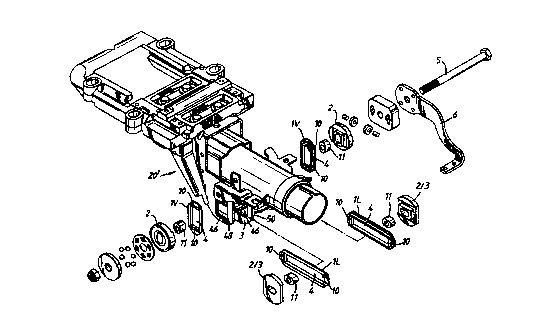Une partie des informations de ce site Web a été fournie par des sources externes. Le gouvernement du Canada n'assume aucune responsabilité concernant la précision, l'actualité ou la fiabilité des informations fournies par les sources externes. Les utilisateurs qui désirent employer cette information devraient consulter directement la source des informations. Le contenu fourni par les sources externes n'est pas assujetti aux exigences sur les langues officielles, la protection des renseignements personnels et l'accessibilité.
L'apparition de différences dans le texte et l'image des Revendications et de l'Abrégé dépend du moment auquel le document est publié. Les textes des Revendications et de l'Abrégé sont affichés :
| (12) Demande de brevet: | (11) CA 2204156 |
|---|---|
| (54) Titre français: | COLONNE DE DIRECTION REGLABLE |
| (54) Titre anglais: | ADJUSTABLE STEERING COLUMN |
| Statut: | Réputée abandonnée et au-delà du délai pour le rétablissement - en attente de la réponse à l’avis de communication rejetée |
| (51) Classification internationale des brevets (CIB): |
|
|---|---|
| (72) Inventeurs : |
|
| (73) Titulaires : |
|
| (71) Demandeurs : |
|
| (74) Agent: | NORTON ROSE FULBRIGHT CANADA LLP/S.E.N.C.R.L., S.R.L. |
| (74) Co-agent: | |
| (45) Délivré: | |
| (86) Date de dépôt PCT: | 1995-11-13 |
| (87) Mise à la disponibilité du public: | 1996-05-30 |
| Licence disponible: | S.O. |
| Cédé au domaine public: | S.O. |
| (25) Langue des documents déposés: | Anglais |
| Traité de coopération en matière de brevets (PCT): | Oui |
|---|---|
| (86) Numéro de la demande PCT: | PCT/GB1995/002658 |
| (87) Numéro de publication internationale PCT: | WO 1996015931 |
| (85) Entrée nationale: | 1997-04-30 |
| (30) Données de priorité de la demande: | ||||||
|---|---|---|---|---|---|---|
|
Mécanisme de serrage pour la colonne de direction réglable d'un véhicule dans lequel des éléments antifrottement (1) sont prévus pour s'interposer entre des parties coulissantes (2, 3) relativement d'une construction (20) de colonne de direction réglable, chaque élément autorisant un coulissement entre des butées d'arrêt comprenant un moyen résilient (10) placé entre les butées pour assurer un arrêt en douceur. Le moyen résilient peut être un élément séparé ou des parties résilientes (10) prévues aux extrémités d'une fente (4) formée dans l'élément. Les parois de l'élément peuvent comporter des rainures longitudinales pour compenser la tolérance de fabrication.
A clamping mechanism for an adjustable steering column for a vehicle in which
antifriction elements (1) are provided which interpose between relatively
sliding components (2, 3) of an adjustable steering column construction (20)
each element allows sliding between limiting stops with resilient means (10)
between the stops to provide a soft stop. The resilient means may be a
separate member or resilient portions (10) at the ends of a slot (4) in the
element. Walls of the element may have longitudinal slits to take up
manufacturing tolerance.
Note : Les revendications sont présentées dans la langue officielle dans laquelle elles ont été soumises.
Note : Les descriptions sont présentées dans la langue officielle dans laquelle elles ont été soumises.

2024-08-01 : Dans le cadre de la transition vers les Brevets de nouvelle génération (BNG), la base de données sur les brevets canadiens (BDBC) contient désormais un Historique d'événement plus détaillé, qui reproduit le Journal des événements de notre nouvelle solution interne.
Veuillez noter que les événements débutant par « Inactive : » se réfèrent à des événements qui ne sont plus utilisés dans notre nouvelle solution interne.
Pour une meilleure compréhension de l'état de la demande ou brevet qui figure sur cette page, la rubrique Mise en garde , et les descriptions de Brevet , Historique d'événement , Taxes périodiques et Historique des paiements devraient être consultées.
| Description | Date |
|---|---|
| Inactive : CIB de MCD | 2006-03-12 |
| Demande non rétablie avant l'échéance | 2003-11-13 |
| Le délai pour l'annulation est expiré | 2003-11-13 |
| Réputée abandonnée - omission de répondre à un avis sur les taxes pour le maintien en état | 2002-11-13 |
| Inactive : Abandon.-RE+surtaxe impayées-Corr envoyée | 2002-11-13 |
| Lettre envoyée | 1997-09-22 |
| Inactive : CIB en 1re position | 1997-08-11 |
| Inactive : CIB attribuée | 1997-08-11 |
| Inactive : Notice - Entrée phase nat. - Pas de RE | 1997-07-29 |
| Inactive : Transfert individuel | 1997-06-30 |
| Inactive : Lettre de courtoisie - Preuve | 1997-06-03 |
| Demande publiée (accessible au public) | 1996-05-30 |
| Date d'abandonnement | Raison | Date de rétablissement |
|---|---|---|
| 2002-11-13 |
Le dernier paiement a été reçu le 2001-10-24
Avis : Si le paiement en totalité n'a pas été reçu au plus tard à la date indiquée, une taxe supplémentaire peut être imposée, soit une des taxes suivantes :
Veuillez vous référer à la page web des taxes sur les brevets de l'OPIC pour voir tous les montants actuels des taxes.
| Type de taxes | Anniversaire | Échéance | Date payée |
|---|---|---|---|
| Taxe nationale de base - générale | 1997-04-30 | ||
| TM (demande, 2e anniv.) - générale | 02 | 1997-11-13 | 1997-04-30 |
| Enregistrement d'un document | 1997-06-30 | ||
| TM (demande, 3e anniv.) - générale | 03 | 1998-11-13 | 1998-10-21 |
| TM (demande, 4e anniv.) - générale | 04 | 1999-11-15 | 1999-10-27 |
| TM (demande, 5e anniv.) - générale | 05 | 2000-11-13 | 2000-10-24 |
| TM (demande, 6e anniv.) - générale | 06 | 2001-11-13 | 2001-10-24 |
Les titulaires actuels et antérieures au dossier sont affichés en ordre alphabétique.
| Titulaires actuels au dossier |
|---|
| THE TORRINGTON COMPANY LIMITED |
| Titulaires antérieures au dossier |
|---|
| LAURENCE GEORGE HERBERT BARTON |